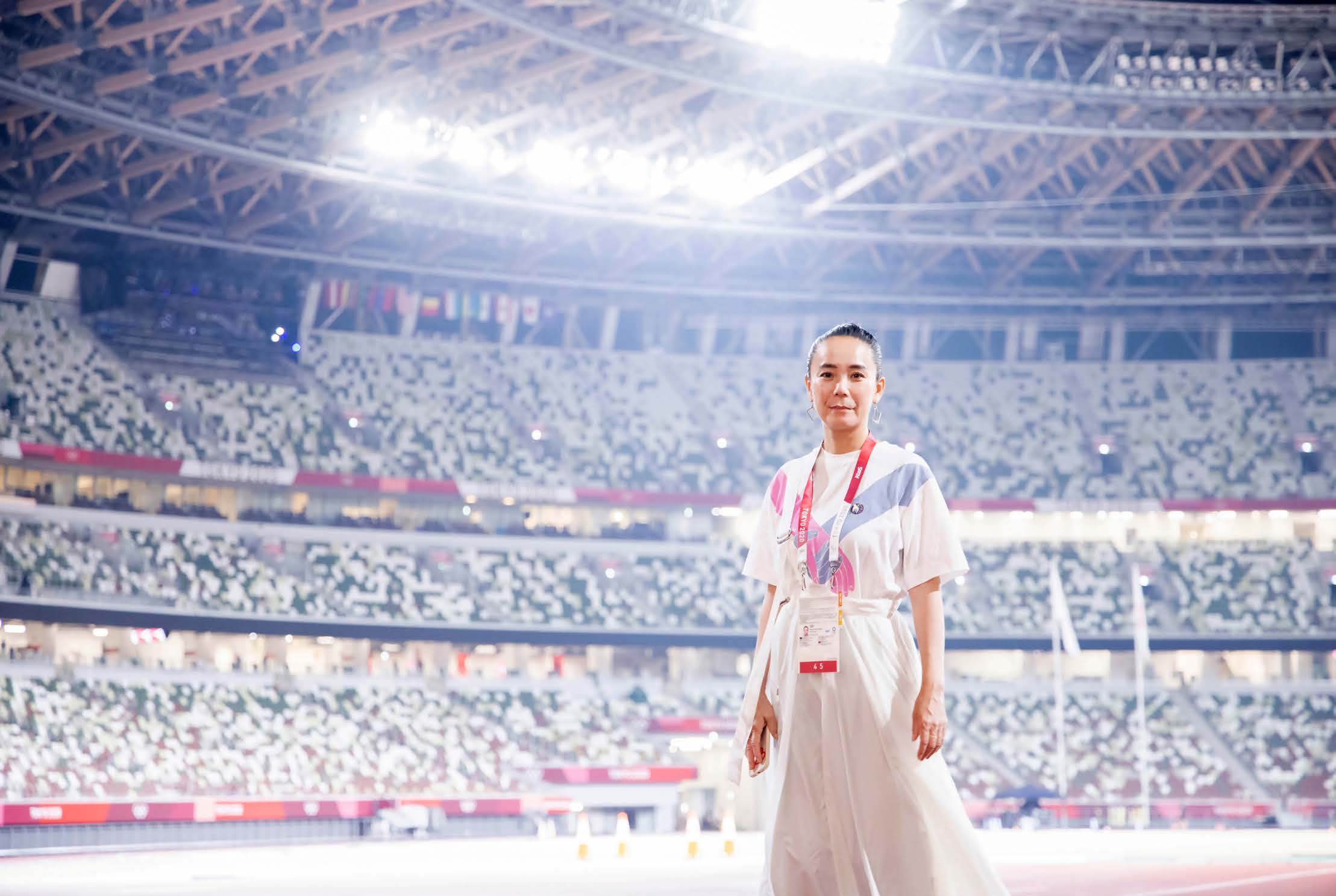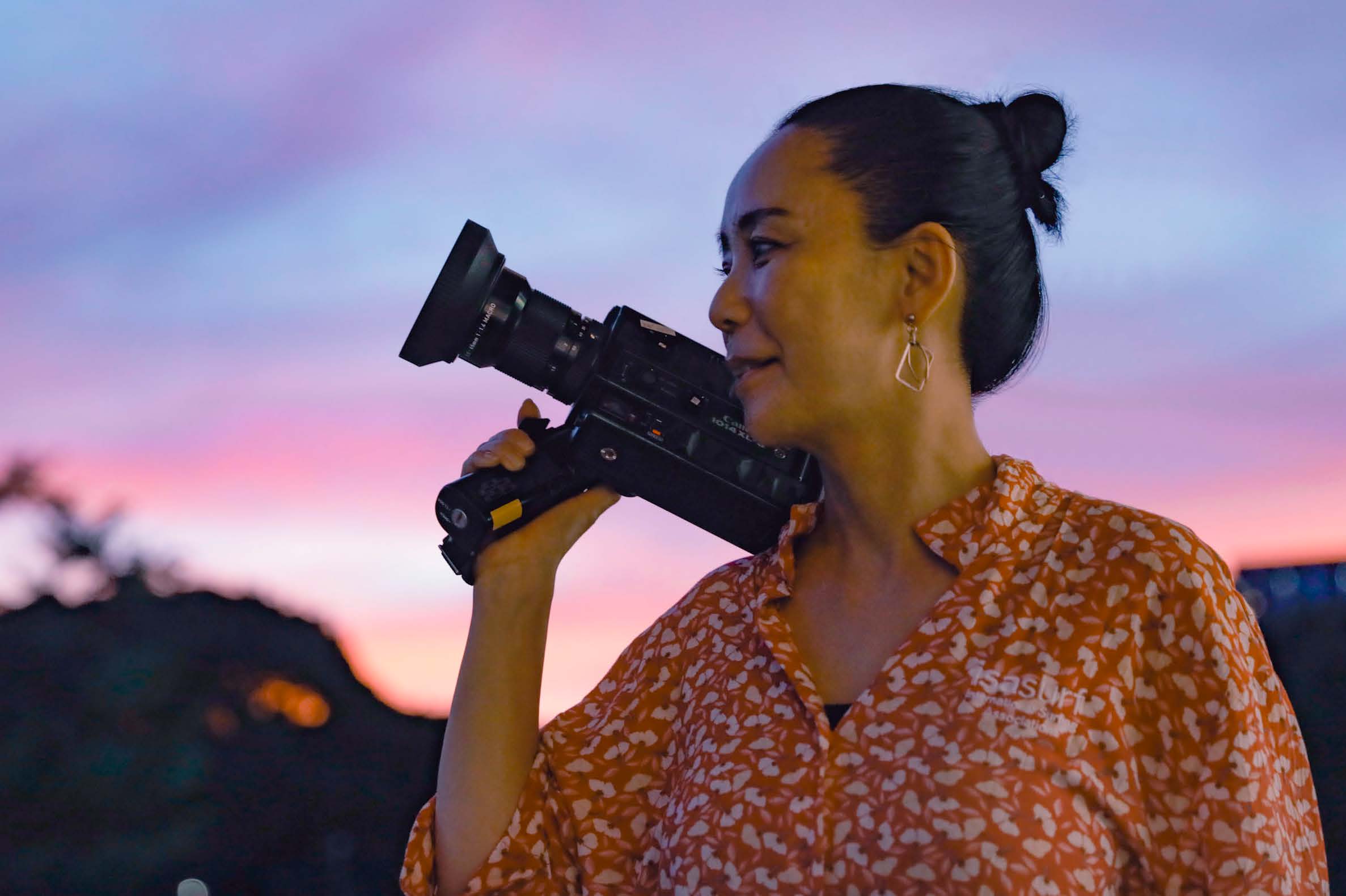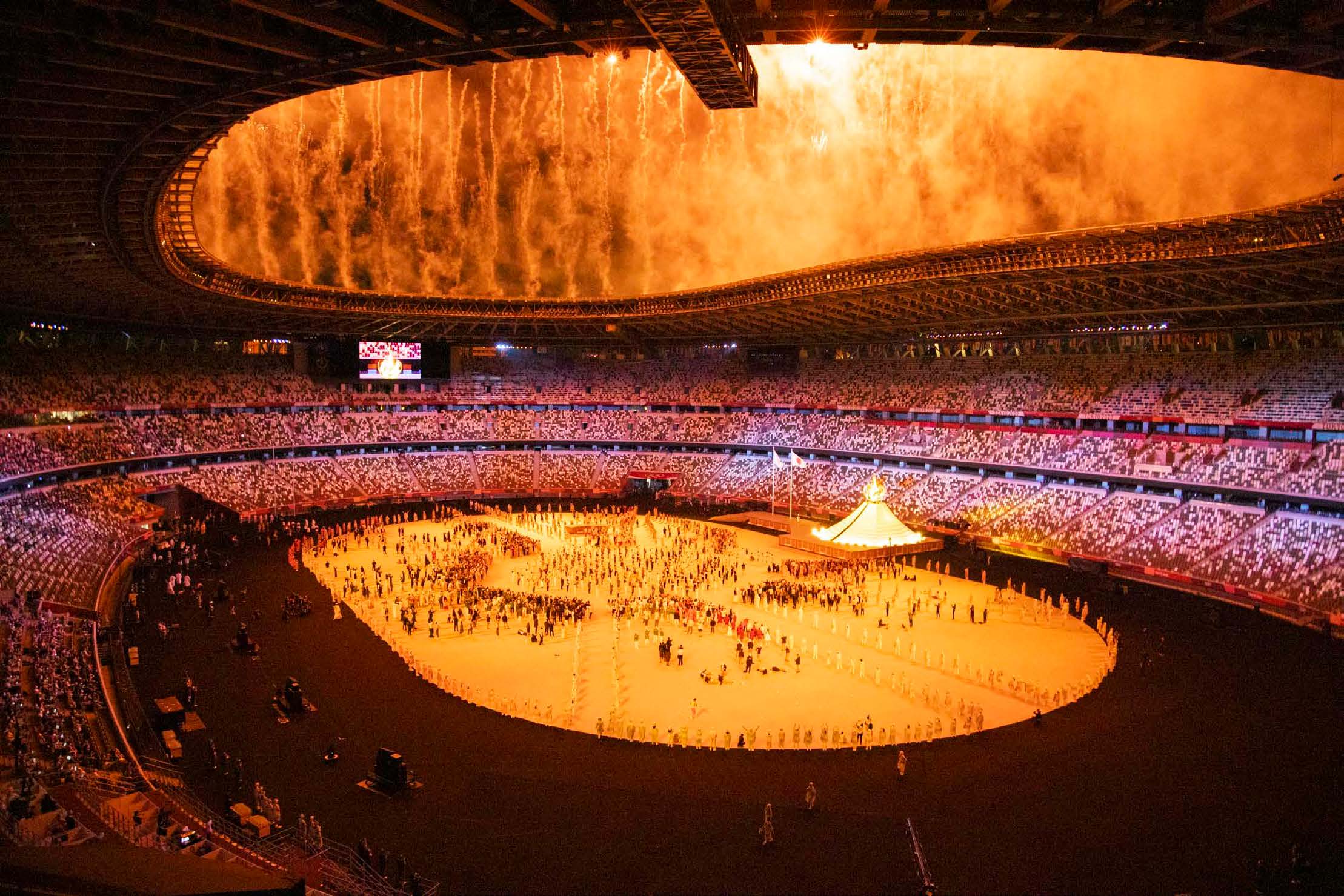
Naomi Kawase, Director of TOKYO 2020. Photo ©2022 International Olympic Committee. All Rights Reserved.
The Official Tokyo 2020 Olympic Film by Naomi Kawase was produced in two parts: one showing the Games from the point of view of the athletes (Side A), and the other of the staff and volunteers (Side B). Side A premiered at the Cannes Film Festival on May 25, 2022.
The film was produced by the Kinoshita Group and the Tokyo 2020 Organizing Committee, in collaboration with the International Olympic Committee (IOC). Naomi Kawase was the youngest filmmaker to win the Caméra d’Or award for best debut director at the Festival de Cannes with her first feature, Suzaku, released in 1997. She is the first Japanese woman to be appointed a UNESCO goodwill ambassador in recognition of her film work, which focuses on the stories of women across generations.
Yas Mitsuwa arranged this interview and did simultaneous translation during our video conference.
Jon Fauer: When and how did the concept of TOKYO 2020 begin and evolve?
Naomi Kawase: It was in the spring or early summer of 2018. The Olympic Organizing Committee got in touch with me. They said, “You are one of the nominees to direct the official Tokyo 2020 Olympic film. How would you make it if you are selected?” I submitted some proposals and was selected in early fall of 2018. We started shooting the pre-events in 2019; the pandemic began during shooting, and then the Olympic games were postponed for one year.
Did your concept change as a result?
Yes. Originally, I wanted to focus on the volunteers in 2020. When Tokyo was selected to host the Olympics, they promoted “Omotenashi,” the hospitality of the Japanese. I thought the Olympics would be a great opportunity for us to demonstrate our hospitality to athletes and visitors. I wanted to introduce the delicate care and the Japanese spirit, characteristics, and virtue through the volunteers.
I was also interested in how Tokyo would be changed. I planned to record how the athletes’ village was constructed and how the bay area of Tokyo would be developed. Of course, I wanted to shoot the competitions of top athletes and convey stories beyond the competition. In that sense, I imagined something like a normal official film should be.
In addition to that, we had the Great East Japan Earthquake
in 2011 and the tragic accident of the nuclear power plant in Fukushima. During the campaign to host the Olympics, one of the themes was the Recovery Olympics and they wanted to get rid of the negative impression of the name “Fukushima.” So I wanted to take what happened in Fukushima when the Olympics came and how cities and villages were changed.
I had all these plans for the film, but the situation changed because of COVID-19. For example, there were rules of social distancing and we could not get close to the athletes. We could not place our camera at the positions we wished. To avoid any chance of infecting the athletes, we could not even interview them during the postponement. To be honest, I wish I could interview athletes without limitations, so that we could see better what they were really thinking and feeling in their hearts.
Was the style of TOKYO 2020 (both sides) planned from the beginning—for example, the extreme close-ups in interviews and the cutaways of nature showing the changing seasons?
I usually interview a person with the minimum number of crew members: a cinematographer, a sound recordist, and me, in order not to put pressure on the interviewee. It is my style to do extreme close-ups of the interviewees, so that we can capture subtle changes in their facial expressions. I consciously shot these interviews with that point of view.
The cutaways of nature show the changing seasons as you mentioned. They show not only the four seasons of Japan but also the fact that one year had passed due to the postponement of the games because of the pandemic. This is also one of styles that I like to employ.
I saw production stills of you with a Canon 1014XL-S 8mm film camera. That reminded me of Jean-Luc Godard.
I shot nature scenes with Super 8 and 16mm film cameras. The
16mm film camera was my Canon Scoopic. The Scoopic was my very first film camera. It is a good camera. (We are on Zoom and Ms. Kawase holds up her Scoopic.)
There’s a picture of you interviewing IOC President Thomas Bach, right up close to his face. What camera was that?
That was shot with an off-the-shelf handheld video camcorder. It was small and the only thing I needed to do was press a REC button. An autofocus lens is built in. It helped me to get closer to the interviewees. Physical distance is sometimes proportional to psychological distance. I was the only one allowed to go close to Mr. Bach, so I had to be the Director/DP. But I did not want to make a rattling noise with my 8mm film camera during the interview, so I used the small consumer video camcorder. It worked really well and he was not self-conscious. You could not do that with a regular crew.
The sound design was very quiet. That was interesting. When we watched the Tokyo Olympics on TV, it seemed very noisy. Maybe the networks added noise?
Actually, I invited a sound designer from France who always works on my feature films to do the final mixing. We had a dozen sound recordists on the Olympic locations and recorded the sound there. As you mentioned, it was a bit noisy at the venue. Music was also being played there and we also heard announcements over the public address system. In other words, sound composition for the venue was mostly recorded in post.
Please talk about the logistics in terms of production schedule, planning, shot lists, picking crews and all the details. I expect they were daunting.
We had to submit all the camera positions by March 2020. But in reality, there were so many things to think about. For example, we had to imagine where the badminton courts were located and what images could be shot by looking at the floorplans. The deadline to submit the camera positions was very strict and we could not place our cameras without this process. It was not a situation where cinematographers could come and go as they wanted, as was the case with Kon Ichikawa’s 1965 Tokyo Olympiad. Now broadcasting is important and OBS (Olympic Broadcasting Services) kept all the best positions for their cameras. There was a rule that we could not appear in frame in the images of OBS and if we were, we would be penalized and could not film the game any further. We could use anything shot by OBS but did not have a freedom of placing cameras. All these processes and negotiations to apply for the camera positions was troublesome.
You got some great shots that I have never seen before. Especially a super long lens shot of Naomi Osaka at the Opening Ceremony. I did not see that on TV.
We also applied for these unique camera positions in advance and OBS granted permission for that setup.
How did you coordinate with the main DP Masaya Suzuki and the rest of the crew?
Masaya was the DP of the film I shot before Tokyo 2020. I decided to go with cinematographers who had experience
in documentary projects. Masaya also has many friends and brains in the film industry, and he helped us to coordinate the best crew members. We also asked the documentary specialists from Yutaka Yamazaki’s team, with whom I often work together, especially on documentary projects.
Are you interested in technical things? If so, would you care to discuss how the cameras and lenses were picked?
I have some film cameras and have been shooting by myself since I was in my 20s. But I asked Masaya to select all the cameras and the lenses for this project.
But I guess you were also shooting a lot of scenes by yourself as well as directing?
That’s right. (Ms. Kawase holds up a number of cameras.) Here is my Elmo Super 8. And this my Fujica ZC1000 Single-8. It is almost like a decoration at the office now. My treasure.
Right: ©2022 International Olympic Committee. All Rights Reserved.
Were you influenced by Kon Ichikawa’s Tokyo 1964 film?
I think I was influenced by Kon Ichikawa’s film and we shared a common understanding of what we were shooting. This is not a pure documentary film. It is a film that contains narrative and storytelling. I think TV can take care of accurately recording the facts. I wanted to make a work of filmmaker Naomi Kawase.
How could you get so close to many key people and athletes?
I think we were able to get close to these athletes and key people because of the amount of time we put into it. We started the project in 2018, kept shooting for 3 years, and spent almost 4 years to complete these official Olympic films. So I was confident and happy to make two films: Side: A and Side: B. Side: A focuses on the athletes. And Side: B focuses on the COVID-19 situation, people of the Organizing Committee, and other staff behind the Olympics. This shows how Japanese people arranged and held the Olympic Games.
Unfortunately, rumors about the Olympics were severe. Although it was an honor for Japan to be awarded a world-class sports event, many people in Japan also had negative feelings due to fear of COVID-19. Almost 80% of the population objected to holding it. So I shot the events as well as the demonstrations. But I also wanted to show how the future is entrusted to the children. That is true and real. I myself was not biased in any direction in these films and I tried to look at what was happening objectively.
That was a debate held around the world. Were you worried about your health and that of your crew?
Japan is an island country. At first, we subconsciously tended to feel that we were protected. But the world is connected. I felt anxious about the possible collapse of medical care and the chaos of society, but I think it was a good opportunity for us to think about these potential problems.
We are ones who express ourselves. I believe we should not be influenced by the moods that are generated from news.
At that time, March-April 2020 was pretty scary in New York. All productions had shut down. Offices were closed. People were terrified. The government was in denial.
Do you remember the scene at the beginning of the film? New York, Los Angeles and other cities in the world. Times Square was empty. Everywhere on this planet had more or less the similar situation. Thankfully I have friends all over the world and they filmed the places where they were. In a sense, we have to tell the truth with motion pictures. We have to show what
is happening at that time. However this is not enough. As Kon Ichikawa said, we have to tell the story. It would be great if people learn something from films. In the future, people who watch the film may think about the situation in Japan and the world at that time.
Did you approach the film with a neutral or subjective point of view?
Both. First of all, my position was neutral. But of course, there was another Naomi Kawase’s point of view. She was always thinking about the film objectively. It is difficult to tell… one is Naomi Kawase myself and the other is Director Naomi Kawase.
Would you like to discuss your personal point of view?
I love mathematics. I usually try to be neutral, as I calculate too much. Many people have the opposite image of Naomi Kawase. I am considered to be natural, as my films have many scenes
of nature and kind people, and I always try to express human emotions. But I have to be a calculating woman to realize them as a feature film.
So should I dare to say what I thought the theme was—from my point of view in the audience? I have been to Japan many times. I thought you presented a very interesting view of Japanese society. The way you focused on women athletes and their babies was something that no Olympic film had done before. It is a human story. With a humanistic point of view. The event itself was politicized and sometimes nationalistic. But you went above those things to show a lot of human emotions.
Thank you. Because I am a woman. As a director, it has been very hard to make films in the last 30 years. It was very hard because I am a woman and Japanese. Maybe women athletes are in a similar situation.
Do you remember the marathon runner in the film, Aliphine Tuliamuk from the USA? She is a mother and came to the Olympics with her husband. He took care of their baby at the hotel in Tokyo. That was very touching. Her husband said she is an athlete but is also a human being. This is not only an issue of gender equality. It reminds me of the song We are the World.
How did you get into the film business and why did you want to be a film director? Especially if it is so difficult in Japan.
I live in Nara. Here, it is mostly countryside, far from Tokyo. The situation here is also different from Tokyo. In my generation, my friends got married at around 20 years old and had children. I was different as I wanted to make films.
I did not have my parents. When I was born, my parents divorced. I was adopted by an elderly couple who were distant relatives in their 60s and did not have children. Since I was small, I have been thinking, why was I born? Who am I? I was very confused when I was a child. My life suddenly changed when I was 18 years old. I met a Super 8 camera at that time. I shot a scene of ordinary life in the real world. When I projected the developed film in a dark room, I was surprised to see that I could see images from time that had already passed. I thought it was a miracle. I could not be positive in my life, as I did not have my parents and I was poor; however film changed my life.
Left: ©2022 International Olympic Committee. All Rights Reserved.
You remind me of François Truffaut and the Antoine Doinel cycle.
Film is my other life. I never really thought of it, because we’ve already done it. Film offers a way of expressing ourselves and explanations of why we do things, sorting out our dreams and emotions.
You said that there was a competition to get the Olympic film job. How was the selection process done?
I do not know the details but I heard there were 4 candidates for director. There were several parameters: first, the director should be known worldwide. Second, the director should be from the host country. And third, the director should be unique.
Well deserved. Congratulations. What are you working on now? What’s next?
We recently had the Nara international Film Festival. I am the executive director of the festival. Since Mogari no Mori (The Mourning Forest) that won the Grand Prix at Cannes in 2007, many people took an interest in Nara, which is the location of the film and my hometown. However, Nara’s economy is not that good. I felt that its good culture is disappearing here and decided to hold a film festival. I have been working on it since the Olympic project. Actually, Nara is a nice place. Please visit Nara when you come to Japan. You are always welcome.
I also want to shoot another film but my next project is Expo 2025 Osaka. I am the producer of the event and will have a pavilion Naomi Kawase. There are fewer than 1000 days until the event. I have to start preparing for it in earnest. There will be a new style of theater. A representative of audience will talk to a person on the screen, but they do not know if it is real or fiction.
I look forward to visiting both Nara and your Osaka pavilion. Thank you.















